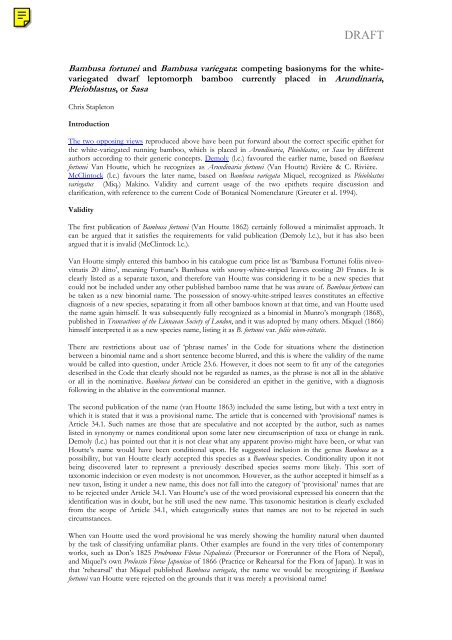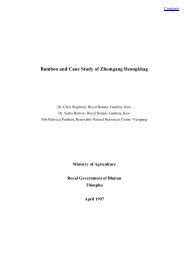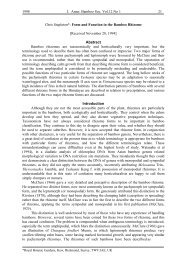Bambusa fortunei and Bambusa variegata: competing names
Bambusa fortunei and Bambusa variegata: competing names
Bambusa fortunei and Bambusa variegata: competing names
You also want an ePaper? Increase the reach of your titles
YUMPU automatically turns print PDFs into web optimized ePapers that Google loves.
DRAFT<br />
<strong>Bambusa</strong> <strong>fortunei</strong> <strong>and</strong> <strong>Bambusa</strong> <strong>variegata</strong>: <strong>competing</strong> basionyms for the whitevariegated<br />
dwarf leptomorph bamboo currently placed in Arundinaria,<br />
Pleioblastus, or Sasa<br />
Chris Stapleton<br />
Introduction<br />
The two opposing views reproduced above have been put forward about the correct specific epithet for<br />
the white-variegated running bamboo, which is placed in Arundinaria, Pleioblastus, or Sasa by different<br />
authors according to their generic concepts. Demoly (l.c.) favoured the earlier name, based on <strong>Bambusa</strong><br />
<strong>fortunei</strong> Van Houtte, which he recognizes as Arundinaria <strong>fortunei</strong> (Van Houtte) RiviÄre & C. RiviÄre.<br />
McClintock (l.c.) favours the later name, based on <strong>Bambusa</strong> <strong>variegata</strong> Miquel, recognized as Pleioblastus<br />
variegatus (Miq.) Makino. Validity <strong>and</strong> current usage of the two epithets require discussion <strong>and</strong><br />
clarification, with reference to the current Code of Botanical Nomenclature (Greuter et al. 1994).<br />
Validity<br />
The first publication of <strong>Bambusa</strong> <strong>fortunei</strong> (Van Houtte 1862) certainly followed a minimalist approach. It<br />
can be argued that it satisfies the requirements for valid publication (Demoly l.c.), but it has also been<br />
argued that it is invalid (McClintock l.c.).<br />
Van Houtte simply entered this bamboo in his catalogue cum price list as ‘<strong>Bambusa</strong> Fortunei foliis niveovittatis<br />
20 ditto’, meaning Fortune’s <strong>Bambusa</strong> with snowy-white-striped leaves costing 20 Francs. It is<br />
clearly listed as a separate taxon, <strong>and</strong> therefore van Houtte was considering it to be a new species that<br />
could not be included under any other published bamboo name that he was aware of. <strong>Bambusa</strong> <strong>fortunei</strong> can<br />
be taken as a new binomial name. The possession of snowy-white-striped leaves constitutes an effective<br />
diagnosis of a new species, separating it from all other bamboos known at that time, <strong>and</strong> van Houtte used<br />
the name again himself. It was subsequently fully recognized as a binomial in Munro’s mongraph (1868),<br />
published in Transactions of the Linnaean Society of London, <strong>and</strong> it was adopted by many others. Miquel (1866)<br />
himself interpreted it as a new species name, listing it as B. <strong>fortunei</strong> var. foliis niveo-vittatis.<br />
There are restrictions about use of ‘phrase <strong>names</strong>’ in the Code for situations where the distinction<br />
between a binomial name <strong>and</strong> a short sentence become blurred, <strong>and</strong> this is where the validity of the name<br />
would be called into question, under Article 23.6. However, it does not seem to fit any of the categories<br />
described in the Code that clearly should not be regarded as <strong>names</strong>, as the phrase is not all in the ablative<br />
or all in the nominative. <strong>Bambusa</strong> <strong>fortunei</strong> can be considered an epithet in the genitive, with a diagnosis<br />
following in the ablative in the conventional manner.<br />
The second publication of the name (van Houtte 1863) included the same listing, but with a text entry in<br />
which it is stated that it was a provisional name. The article that is concerned with ‘provisional’ <strong>names</strong> is<br />
Article 34.1. Such <strong>names</strong> are those that are speculative <strong>and</strong> not accepted by the author, such as <strong>names</strong><br />
listed in synonymy or <strong>names</strong> conditional upon some later new circumscription of taxa or change in rank.<br />
Demoly (l.c.) has pointed out that it is not clear what any apparent proviso might have been, or what van<br />
Houtte’s name would have been conditional upon. He suggested inclusion in the genus <strong>Bambusa</strong> as a<br />
possibility, but van Houtte clearly accepted this species as a <strong>Bambusa</strong> species. Conditionality upon it not<br />
being discovered later to represent a previously described species seems more likely. This sort of<br />
taxonomic indecision or even modesty is not uncommon. However, as the author accepted it himself as a<br />
new taxon, listing it under a new name, this does not fall into the category of ‘provisional’ <strong>names</strong> that are<br />
to be rejected under Article 34.1. Van Houtte’s use of the word provisional expressed his concern that the<br />
identification was in doubt, but he still used the new name. This taxonomic hesitation is clearly excluded<br />
from the scope of Article 34.1, which categorically states that <strong>names</strong> are not to be rejected in such<br />
circumstances.<br />
When van Houtte used the word provisional he was merely showing the humility natural when daunted<br />
by the task of classifying unfamiliar plants. Other examples are found in the very titles of contemporary<br />
works, such as Don’s 1825 Prodromus Florae Nepalensis (Precursor or Forerunner of the Flora of Nepal),<br />
<strong>and</strong> Miquel’s own Prolussio Florae Japonicae of 1866 (Practice or Rehearsal for the Flora of Japan). It was in<br />
that ‘rehearsal’ that Miquel published <strong>Bambusa</strong> <strong>variegata</strong>, the name we would be recognizing if <strong>Bambusa</strong><br />
<strong>fortunei</strong> van Houtte were rejected on the grounds that it was merely a provisional name!
DRAFT<br />
It should also be added that even if the 1863 publication were to be considered invalid under Article 34.1,<br />
that would have no retrospective effect upon the validity of the earlier publication in 1862, in which the<br />
name was not given as provisional.<br />
Therefore it would appear that both 1862 <strong>and</strong> 1863 publications could be considered perfectly valid,<br />
given any inclination to do so.<br />
Current usage<br />
Where the validity of a name is borderline, interpretation of the validity ought to err towards the support<br />
of current usage. McClintock (l.c.) clearly supports this approach, <strong>and</strong> laments the inadequacy of the<br />
Code in supporting nomenclatural stability. In fact the Code has recently been strengthened with this in<br />
mind, <strong>and</strong> a large number of cases where validity is in conflict with current usage have recently been<br />
brought to the attention of the International Committee for Botanical Nomenclature. Proposals routinely<br />
request formal <strong>and</strong> binding conservation of a name in current use <strong>and</strong> rejection of another technically<br />
correct but little-used name. A proposal to conserve the widely used name Thyrsostachys siamensis for the<br />
elegant tropical Monastery Bamboo, despite the existence of an earlier <strong>and</strong> technically correct name,<br />
Thyrostachys regia, is but one recent example (Stapleton 1998). The Code clearly states that when such a<br />
situation exists, the established usage is to be followed pending a proposal for its conservation, i.e.<br />
established usage should not be upset. In addition a proposal has been made (Greuter 1998) to fully<br />
incorporate the objective of nomenclatural stability as one of the fundamental principles of the Code.<br />
Nomenclatural stability is certainly best served by adoption of the name in widest current use. There is no<br />
conflict between horticulturalists <strong>and</strong> taxonomists on this issue. However, both taxonomy <strong>and</strong><br />
horticulture are now international subjects, <strong>and</strong> any survey of current usage of different <strong>names</strong> has to<br />
investigate which <strong>names</strong> are in use in many different countries. Moreover it would seem reasonable to<br />
give particular emphasis to the <strong>names</strong> used for plants in their country or countries of origin.<br />
McClintock (l.c.) is quite correct in noting that the use of Pleioblastus variegatus is well established,<br />
especially in English horticultural reference books. However, Demoly (l.c.) has countered McClintock’s<br />
suggestion that Pleioblastus variegatus is the ‘now generally used name’, by citing a substantial volume of<br />
literature to support his own contention that <strong>names</strong> based upon <strong>Bambusa</strong> <strong>fortunei</strong> are in even wider use.<br />
When a further range of international scientific literature was consulted at Kew it became apparent that<br />
both <strong>names</strong> have indeed been widely used, but that the epithet <strong>fortunei</strong> is in somewhat wider use. The<br />
difference is greatest between English horticultural works <strong>and</strong> the Asian literature. All the recent works<br />
from China <strong>and</strong> Japan consistently use only the epithet <strong>fortunei</strong>, as well as most of the Continental<br />
European horticultural books on bamboos.<br />
With due respect to David McClintock, <strong>and</strong> to the Chairman of the International Commission for the<br />
Nomenclature of Cultivated Plants, under these circumstances it seems most appropriate to support the<br />
current Asian <strong>and</strong> Continental usage of the epithet <strong>fortunei</strong>, rather than the English horticultural use of the<br />
later name variegatus. It would seem to be desirable for the interpretation of the validity of the publication<br />
of that epithet by van Houtte in 1862 or 1863 to be as favourable as possible.<br />
Incidentally, as Demoly (l.c.) follows the unusual practice of using capital letters for some specific <strong>names</strong><br />
it may be pertinent to mention that he is fully entitled to do so under Recommendation 60F.1 of the<br />
Code, which states: all specific <strong>and</strong> infraspecific epithets should be written with a small initial letter,<br />
although authors desiring to use capital initial letters may do so when the epithets are directly derived<br />
from the <strong>names</strong> of persons (whether actual or mythical), or are vernacular (or non-Latin) <strong>names</strong>, or are<br />
former generic <strong>names</strong>.<br />
Conclusions<br />
The epithet <strong>fortunei</strong> is in wider use than the epithet variegatus, <strong>and</strong> while variegatus is widely used in English<br />
horticultural publications, <strong>fortunei</strong> is consistently used in Japan <strong>and</strong> China, from where the species<br />
originates.<br />
Publication of the name <strong>Bambusa</strong> <strong>fortunei</strong> by van Houtte in either 1862 or 1863 can be considered to be<br />
valid in accordance with the rules. The earlier publication should be followed now that Demoly has
DRAFT<br />
pointed out its existence, <strong>and</strong> the correct <strong>names</strong> in the genera Arundinaria, Pleioblastus, <strong>and</strong> Sasa would<br />
appear to be those based upon it.<br />
References<br />
Demoly, J.-P. (1999): Notes et nouvÄautes nomenclaturales pour des bambous cultivÄs en Europe. In Bambou 29, 12–<br />
13.<br />
Greuter, W. (1998): Proposal to spell out a new principle in the Code: a homage to C<strong>and</strong>olle. In Taxon 47:4, 905–<br />
906.<br />
Greuter, W. et al. (1994): International code of botanical nomenclature (Tokyo Code). In Regnum vegetabile 131<br />
(Koeltz Scientific Books, KÑnigstein, Germany).<br />
van Houtte, L. (1862): Prix-courant de plantes de serres et de plein air 93(1862-1863). Etablissment Horticole de<br />
Louis van Houtte, G<strong>and</strong>, Belgium. (Kew microfiche. No 67, Row 4 frame 4).<br />
van Houtte, L. (1863). Flore des serres et des jardins de l’Europe 15, 69. G<strong>and</strong>, Belgium.<br />
Miquel, F.A.G. (1866). Prolusio florae japonicae. In Ann. Mus. Bot. Lugd. Bat. ii. 285.<br />
Munro, W. (1868): A monograph of the <strong>Bambusa</strong>ceae. In Trans. Linn. Soc. London 26, 1–157.<br />
Stapleton, C.M.A. (1998). (1366) Proposal to conserve the name Thyrsostachys siamensis Gamble against the name<br />
Thyrsostachys regia (Munro) Bennet (Poaceae, Bambusoideae). In Taxon 47:3, 739740.
Pleioblastus <strong>fortunei</strong> not P. variegatus<br />
Jean-Pierre Demoly<br />
DRAFT<br />
Extract from J.-P. Demoly: Notes <strong>and</strong> nomenclatural changes for some bamboos cultivated in<br />
Europe (in Bambou 29, 12–13). Translated by Henk Beentje & Chris Stapleton, with some explanatory<br />
notes in square brackets.<br />
The epithet <strong>variegata</strong> has been used by some botanists (Makino 1900, 1912; Camus 1913; Rehder 1949;<br />
McClure 1966; Lin & Li 1948) despite the priority of the epithet Fortunei, which has been used by the<br />
majority (Munro 1866; Fenzi 1876; Mitford 1896; Houzeau de Lehaie 1908; Fiori 1917; Nakai 1933,<br />
1942; Nemoto 1936; Muroi 1963; Hatsushima 1976; Muroi & Okamura 1977; Suzuki 1978, 1979; Murata<br />
1979; Okamura & Tanaka 1986; Chao 1989 etc.). However, the epithet <strong>variegata</strong> is still in use, since an<br />
article by McClintock (in The plantsman 4, 187) stating that the Fortunei would be invalid according to<br />
Article 34.1 of the Code [concerning so-called provisional <strong>names</strong>]. Indeed, in the publication seen by<br />
McClintock (Flores des Serres, van Houtte 1863) the name <strong>Bambusa</strong> Fortunei is followed in the<br />
commentary by the indication ‘completely provisional name’ but this might signify that it was the<br />
placement in <strong>Bambusa</strong> that was provisional <strong>and</strong> not the specific epithet. However that may be, van Houtte<br />
had already published a name for this bamboo twice, in editions of his catalogue from L’Etablissement<br />
Horticole de Louis van Houtte at G<strong>and</strong>. The first time, in 1861, he called it <strong>Bambusa</strong> <strong>variegata</strong> (p.28). This<br />
name is invalid as it is only accompanied by the note ‘Fortunei’, without description (nomen nudum). The<br />
second time, in 1862, he gave it the name <strong>Bambusa</strong> Fortunei, used in the later editions of his catalogue <strong>and</strong><br />
in his Flora, with the short description ‘foliis niveo-vittatis’, which was enough to distinguish it from other<br />
bamboos at that time [<strong>Bambusa</strong> argenteostriata Regel, a bamboo with similarly variegated but hairy leaves,<br />
being published in 1865]. This name is valid according to Article 30.3, concerning publication in trade<br />
catalogues [as it was published prior to 1953], <strong>and</strong> it cannot be considered provisional.<br />
The prestige enjoyed by van Houtte’s Flore des Serres [as place of publication of <strong>Bambusa</strong> Fortunei, rather<br />
than the earlier catalogue] is probably due to the fact that Munro cited it (in Trans. Linn. Soc. London<br />
26(1868), 111). He was the first author to re-use the name <strong>Bambusa</strong> Fortunei in a monograph, <strong>and</strong> this<br />
reference [to the Flore des Serres] has been taken up by later authors, who did not notice that van Houtte<br />
had himself cited his [earlier] catalogue in the Flore des Serres.<br />
Pleioblastus variegatus not P. <strong>fortunei</strong><br />
David McClintock<br />
In the last number of Bambou (1998), Dr Demoly wrote that he had discovered that van Houtte (1862)<br />
had validly published the epithet <strong>fortunei</strong>, thus rendering the epithet variegatus published later by Miquel<br />
(1866) a synonym. He mentioned that I had written in 1982 that van Houtte (1863) had specifically stated<br />
that his use of the epithet <strong>fortunei</strong> was provisional, ergo invalid. Demoly graciously sent me a draft of his<br />
paper, on which I made two comments. One was that van Houtte clearly implied in 1863 that his earlier<br />
use of <strong>fortunei</strong> (1862) must also be regarded as provisional. In 1863 no rules existed for valid publication<br />
of new <strong>names</strong>, so van Houtte can have had no inkling that in using the name <strong>fortunei</strong> a year earlier he had<br />
unwittingly given it validity in the eyes of later generations. Thus there seemed good grounds for<br />
retaining the now generally used name variegatus. My other comment was that a principle ought to be in<br />
the Code (but regrettably is not yet) to the effect that if there is any doubt about the validity of a name<br />
change, do not upset established usage. Demoly made no reference to my caveats. I find my thoughts<br />
supported by Chris Brickell, the Chairman of the International Commission for the Nomenclature of<br />
Cultivated Plants. The name Pleioblastus variegatus will not be altered in The plant finder, nor, I hope,<br />
elsewhere.<br />
References<br />
Demoly, J.-P. (1999): Notes et nouvÄautes nomenclaturales pour des bambous cultivÄs en Europe. Bambou 29, 12–13.<br />
van Houtte, L. (1862): Prix-courant de plantes de serres et de plein air 93(1862-1863). Etablissment Horticole de<br />
Louis van Houtte, G<strong>and</strong>, Belgium.<br />
van Houtte, L. (1863). Flore des serres et des jardins de l’Europe 15, 69. G<strong>and</strong>, Belgium.<br />
McClintock, D. (1982): Two familar bamboos. In The plantsman 4:3, 187.<br />
Miquel, F.A.G. (1866). Prolusio florae japonicae. In Ann. Mus. Bot. Lugd. Bat. 2, 285.





